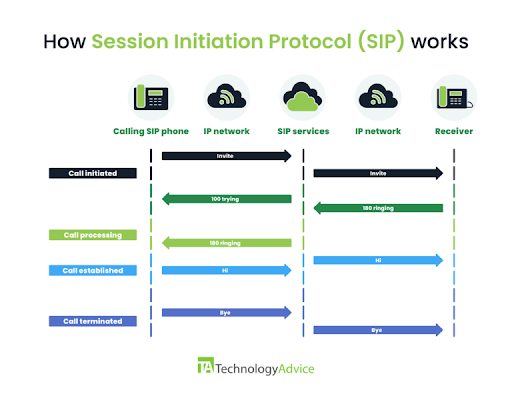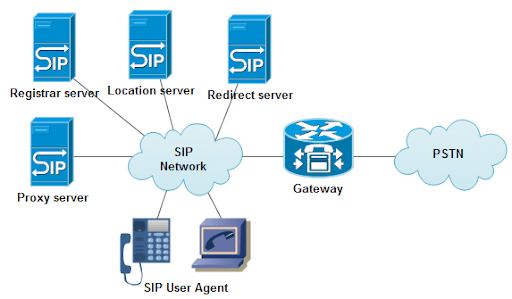SIP Protocol Explained: How It Powers Modern VoIP and UC
Enterprise voice today hinges on more than just uptime. It also requires agility, security, and complete control over how sessions begin, behave, and end.
Session Initiation Protocol (SIP) makes that possible. It’s the backbone of modern Voice over Internet Protocol (VoIP) systems and cloud-based communications, quietly powering everything from hybrid call centers to remote-ready voice infrastructure.
You likely use SIP in some form. But as global operations expand and security demands increase, understanding how SIP works and its evolution can inform critical decisions around architecture, vendor selection, and long-term voice strategy.
This guide explains how the SIP protocol works, how it fits in with VoIP and SIP trunking, and why trends like SIP over Quick UDP Internet Connections (QUIC) matter.
SIP protocol 101: How it works
SIP defines how systems initiate and manage voice and video calls across IP networks, making it a core technology behind modern internet telephony. It doesn’t carry the call—that’s a job for other protocols—but it makes sure the system sets up and tears down calls successfully.
Below are the key actions SIP performs each time someone places a call:
- Initiates the session by locating the recipient, negotiating codecs, and starting the connection.
- Manages the session by adding participants or placing someone on hold during the call.
- Ends the session when the call finishes, releasing all associated network resources.
These steps apply to all types of SIP communications, whether it’s a simple phone call, a SIP call between distributed teams, or a large video conferencing session.


SIP architecture components
To understand SIP better, it’s essential to look at how it transmits messages between its core components. These components are critical for managing and routing SIP calls.
- User agents are the devices or applications—such as IP phones, softphones, or mobile apps—that act as endpoints to initiate and receive SIP requests.
- Proxy servers route those requests between endpoints and apply business logic, like call permissions or routing rules.
- Registrar servers keep track of user locations. When someone connects to the network, they register here so other devices can reach them.
SIP vs. RTP: Understanding the division
While SIP establishes the framework for managing voice communication, Real-Time Transport Protocol (RTP) takes care of the actual delivery of voice data. Here’s how they work together:
- SIP manages signaling. It establishes connections, negotiates capabilities, and handles call control functions. You’ll see SIP in action when calls ring, transfer, or end.
- RTP handles media transport. Once SIP establishes a session, RTP carries the voice data between endpoints. This ensures consistent audio delivery for high-quality VoIP calls.
The division between the protocols allows you to independently optimize each one for its specific role—SIP for call reliability and RTP for audio quality.
Example: If you’re troubleshooting call quality, SIP will help you understand if you set up the call correctly. For audio issues, you should dig into the RTP stream.
SIP protocol vs. SIP trunking vs. VoIP: What's the difference?
SIP protocol, SIP trunking, and VoIP are often confused, but each addresses a different aspect of voice communications.
SIP protocol is a network protocol that defines the rules for initiating and managing communication sessions. It's the standard that enables interoperability between different vendors' equipment. SIP often works with the Session Description Protocol (SDP), which negotiates media formats and parameters for the voice stream.
SIP trunking uses the SIP protocol and a SIP proxy server to connect your private voice systems to public networks. Instead of using traditional phone lines, you get voice connectivity through an internet connection. SIP trunking’s benefits and advantages extend beyond cost savings to include improved scalability and reliability.
VoIP refers to the broader category of Voice over IP networks. Unlike SIP protocol, which only manages signaling, VoIP covers the entire transmission of voice data. While SIP trunking is one method of connecting phone systems to the public network, VoIP is the underlying technology that makes the calls possible.
Understanding the differences between VoIP and SIP will help you make informed decisions about your voice infrastructure.
Here’s a simple way to think about the relationship:
- SIP is the how behind the call setup and control.
- SIP trunking is the connection to the outside world.
- VoIP is the result—the voice call traveling over the internet.
For global teams, SIP trunking helps them consolidate their voice infrastructure across multiple countries. It also ensures consistent voice quality while reducing the hassle of managing several telecom providers. With the right setup, you get stronger global connectivity with fewer moving parts.
Did you know? AVOXI helps enterprises connect SIP-based platforms, like Microsoft Teams or Genesys, to local voice infrastructure in over 150 countries. With features like TrueLocal™ for local number presence and built-in diagnostics, you can expand globally without the complexity associated with handling multiple vendors.
SIP security essentials for the modern enterprise
While understanding the fundamentals of SIP, SIP trunking, and VoIP is crucial for building an effective communication infrastructure, securing your infrastructure is equally important. As enterprises scale their voice systems using SIP, they must also address its potential security risks. Let's explore the key threats and protective measures every organization must implement for robust SIP security.
The most common SIP-based threats
SIP isn’t inherently secure. Without proper protections in place, attackers can exploit it to intercept calls, steal data, or flood systems. Below are the most frequent types of threats:
- Call interception: Attackers can monitor SIP messages to capture audio or reroute calls without detection.
- Spoofing and toll fraud: Bad actors may impersonate trusted sources or abuse the system to make unauthorized long-distance calls.
- Spam over IP telephony (SPIT): Similar to email spam, SPIT is a VoIP spam tactic that targets users with fake robocalls or phishing attempts that originate from SIP-based systems.
These threats don’t just cause massive security breaches—they quietly erode trust, increase costs, and complicate compliance. To put a dollar figure on it, annual losses from fraud and security breaches may exceed $45 billion in 2025, reflecting the widespread nature and costly risks they have become.
How enterprises protect SIP infrastructure against these threats
As SIP becomes central to enterprise communications, securing it is crucial. While encryption helps protect data, it’s just one layer of protection. To fully safeguard SIP infrastructure, businesses must address threats across the following points:
- Transport Layer Security (TLS) encryption protects the signaling layer, ensuring that call setup messages remain confidential and secure.
- Secure Real-Time Transport Protocol (SRTP) encrypts the media stream, protecting voice data from interception during a call.
- Network Address Translation (NAT) traversal supports secure communication, even when devices are behind firewalls or private networks.
- Rate limiting and SIP authentication block traffic floods and unauthorized access attempts to SIP endpoints.
While these measures are essential for securing SIP infrastructure, encryption alone doesn’t provide complete protection. To effectively safeguard against threats, enterprises also need real-time visibility into call behavior and the ability to quickly respond when issues arise. This is why provider-level monitoring is crucial.
Voice service providers should offer built-in tools to detect anomalies, flag fraud attempts, and surface issues before they disrupt operations. Proactive measures—like identifying threats in real-time rather than after they cause damage—are essential for maintaining the integrity of your system. Preventing phone fraud in VoIP communications helps ensure you catch threats early, safeguarding your infrastructure from serious breaches.
As enterprises continue to enhance their SIP infrastructure, SIP over QUIC emerges as a promising innovation to address both performance and security challenges.
Emerging trends: SIP over QUIC and the future of real-time communications
As the demand for faster, more secure real-time communication grows, SIP over QUIC is gaining attention as a solution to enhance the speed and reliability of SIP-based systems.
Originally developed by Google, QUIC improves connection setup times and encrypts traffic more effectively than traditional protocols, making it an ideal choice for modern voice and video communications.
What SIP over QUIC means for voice
SIP over QUIC replaces the traditional Transmission Control Protocol (TCP) or User Datagram Protocol (UDP) transport layers with QUIC. This approach benefits enterprises that manage large-scale or latency-sensitive voice infrastructure. The key advantages include:
- Faster connection setup: QUIC reduces the time it takes to establish a session by combining multiple steps into one handshake.
- Built-in encryption: This feature encrypts all data by default, simplifying compliance and boosting privacy.
- Multiplexing: It also allows multiple streams to run simultaneously without interference, which reduces head-of-line blocking and improves call reliability.
Together, these features make SIP over QUIC a promising option for high-performance voice.
What’s holding it back
Despite its potential, most enterprises haven’t yet deployed SIP over QUIC. Here’s what’s limiting adoption:
- Compatibility and vendor support: Many SIP platforms and devices don’t support QUIC, and many SIP carriers haven’t fully rolled out support, making it difficult for enterprises with hybrid or multi-vendor systems to implement.
- Limited diagnostic tools: Fewer tools exist for monitoring and troubleshooting QUIC compared to UDP and TCP, which hinders visibility and problem resolution.
- Network infrastructure challenges: Some networks aren’t optimized for QUIC, requiring upgrades to fully leverage its performance benefits.
These gaps won’t last forever, but they slow how quickly most organizations can roll out SIP over QUIC.
What to monitor if you're planning ahead
SIP over QUIC isn’t ready for widespread use, but it’s worth keeping on your radar. Below are a few practical steps for teams considering future adoption:
- Monitor Internet Engineering Task Force (IETF) developments and for vendor roadmaps that include QUIC support for real-time voice.
- Review whether your current SIP platforms or session border controllers (SBCs) have plans to add compatibility.
- Identify where latency, call quality, or packet loss might justify a transport-layer upgrade.
Deployment scenarios: How enterprises use SIP today
SIP provides enterprise teams with the flexibility to modernize without starting from scratch. It also supports global reach, streamlines contact center operations, and makes cloud migrations more manageable.
Here’s how SIP plays a role in real-world deployments:
- Integrating with CCaaS platforms: Teams rely on SIP to connect Contact Center as a Service providers, like Genesys, NICE, or Amazon Connect, to regional carriers. Integration enables them to manage Interactive Voice Responses (IVRs), route calls intelligently, and maintain consistent user experiences across regions.
- Simplifying global call routing: SIP makes it easier to centralize control while maintaining a local presence. With support for localized caller ID and regional number plans, enterprises can increase answer rates and cut down on vendors.
- Bridging legacy systems with cloud platforms: Many organizations use SIP to connect on-prem Private Branch Exchange (PBX) systems with Unified Communications as a Service (UCaaS) tools. This hybrid approach future-proofs their phone systems as they transition to the cloud. It also allows for phased migrations that won’t disrupt call flows or internal operations.
SIP’s adaptability has driven widespread adoption. And its cost-saving potential is another key driver. A recent market study found that more than 80% of businesses that switched to SIP trunking reduced their communication costs by 40% to 60%. These results demonstrate why SIP remains a cornerstone of enterprise voice strategy: It gives teams a direct path to scale without sacrificing cost-effectiveness, reliability, visibility, or control.
Did you know? AVOXI’s SIP integration features help businesses centralize voice routing, expand to new markets faster, and connect with global platforms like Microsoft Teams—all through a single cloud-based infrastructure.
Building intelligent voice systems with SIP
SIP adaptability continues to shape how enterprise voice systems operate, providing the flexibility to scale, the control to centralize, and the foundation to support global unified communications. Whether you're integrating cloud platforms or modernizing existing infrastructure, adaptability makes SIP more than a signaling protocol. It also acts as a bridge between legacy systems and cloud-native tools, avoiding a rip-and-replace scenario. With SIP, you can unify global operations while maintaining quality, compliance, and visibility.
Success, however, depends on how you implement SIP. The right partner helps you leverage its full potential—reducing vendor complexity, accelerating provisioning, and improving long-term performance.
AVOXI delivers on the full potential of SIP. With enterprise-ready infrastructure and support for SIP deployment in over 150 countries, AVOXI enables seamless communication, giving global teams more control and reducing overhead. AVOXI’s platform integrates with solutions like Microsoft Teams and Genesys, providing the diagnostics and local number provisioning you need to simplify global deployment and ensure security with encrypted signaling.
Ready to optimize your SIP infrastructure and enhance global communications? Reach out to AVOXI to discover how you can streamline deployment, improve performance, and ensure security across your organization.
Additional Resources to Help You Get the Needle Moving

PSTN Replacement
Guide to Voice Termination Services

Retain Phone Number
International
Number Porting

Virtual Phone Line
Benefits of
SIP Trunking

